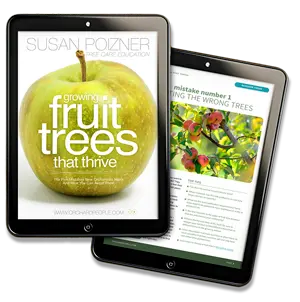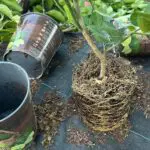How do you choose fruit trees that will work for your landscape? This article and video show you the tips Read more
When to Stop Watering Fruit Trees in the Fall

In the summer, it's clear that we need to water our fruit trees. While we humans sweat in the heat, fruit trees lose water through their leaf pores, called stomata. Without additional moisture during the hot, dry weather, trees become dehydrated – and that affects tree health and harvest quality.
But the question is: When do you need to stop watering fruit trees in the fall? Given the cooler temperatures, the tree won't be losing as much water through transpiration. That is the process by which plants lose water to the atmosphere, primarily through the stomata on their leaves.
To learn more about the science around watering fruit trees in the fall, I spoke to Kevin Folta, Professor of Horticulture at the University of Florida.
Why fruit trees need water in the fall
In order to understand when to stop watering fruit trees in the fall, we need to know why fruit trees need to be well hydrated as they approach winter dormancy. Here are just a few quick points:
- If trees cells freeze during the winter, the cell walls can break, causing damage to the tree. Well-hydrated plant cells resist freezing better.
- Trees absorb soil nutrients in liquid form. If the soil is dry, trees can become malnourished. In the fall, trees are building up nutrient reserves for winter storage in the roots. They will use those nutrients during dormancy and to fuel growth in the spring.
- Finally, a well-hydrated tree is better able to fend off pests and diseases, it will be less likely to suffer winter desiccation, where trees lose more water than they can absorb from frozen ground.
Fruit tree irrigation and soil type
But how much water does your fruit tree need? Well, that will depend on your soil type, according to Kevin Folta. The texture and composition of soil on your site can drastically affect water retention. For example:
- Sandy soils, which are common in Florida where Kevin lives, drain water quickly and need frequent watering.
- In contrast, clay soils retain water for longer, and that reduces the need for frequent watering.
Understanding the type of soil you have is the first step to devising an effective watering strategy for your fruit trees.
How much water do fruit trees need
When it comes to how much water fruit trees need, there is no one-size-fits-all answer – specifically because soils can be vastly different from region to region. In fact, your soil may even be different from the soil in a neighbouring yard.
So, if you want to know how much water your fruit trees need, your best bet is to do what Kevin calls the “Flower Pot Test.”
“Take a pot, a 3-5 gallon flower pot and fill it with the soil that's from your space and water it. Let it settle for a few weeks. Then, water it again and pay attention to where the water moves through it. Because water is a lot like electricity in terms of its flow. It likes a path of least resistance.”
When you do this test, the results can be enlightening. You may think that you have been applying lots of water. But when you look at the flower pot, you may find that the water is working its way through a tiny path or crack in the soil only – leaving the rest of the soil high and dry.
The results of this test will give you some hints about how to water your trees in the future.

Watering newly planted bare root trees
Irrigation will also differ depending on the tree’s age.
For instance, newly planted, bare-root trees need regular watering to help them establish themselves in the weeks and months after planting. Your goal will be to ensure that the roots get watered regularly. That’s because fruit tree nurseries dig these trees out of the ground to send them to customers. Inevitably, the delicate root hairs, also known as feeder roots, are damaged in the process.
So, it’s our responsibility as growers to create an environment that allows those feeder roots to grow and spread out. That will allow the roots to access soil nutrition so that they can both feed the tree, and anchor it to the ground. And to do both of those things, those roots need lots of moisture.
Over-watering fruit trees can also be a problem
While fruit tree roots need water, they also need air! Kevin explains that soil is a matrix that has little spaces in between the soil particles.
“Those little spaces between soil hold water and they hold oxygen and lots of other goodies that plants want and need,” he says.
But what happens if we water too much and the soil is constantly wet? Well, then those tree roots will not be happy and they will be vulnerable to root rot. So the best strategy is to water your tree deeply, and then allow the roots to dry out fully before watering again.
“Water is a blessing and a curse, and most plants have a Goldilocks zone that they like to live in. Some can tolerate a little more moist soils, but in general, keeping it where it dries out between waterings is not a bad idea. It really does help facilitate the plant's defences against pathogens, but also encourages the roots to go and continue to grow and search for more water,” he explains.
Fruit Trees
That Thrive

Watering established fruit trees
As your trees mature, their watering needs evolve.
More mature trees, Kevin explains, still need water, “but you draw back quite a bit (as the fall approaches) and don’t give as much as the days get shorter.”
At that time of year, your fruit trees are preparing for the colder months. They are slowing down their process of photosynthesis and conserving their resources. So, the cooling temperatures and the impending dormancy reduce our fruit trees’ need for water.
Do you water fruit trees in the winter?
If you live in a cold climate, you don’t need to water your fruit trees in the winter at all.
“As the ground freezes, there’s not as much water loss from the plant. So what's on board usually stays on board unless you get wind.”
Windstorms, however, can cause trees to dry out so it’s important to keep a close eye on the soil after a windstorm to see if your fruit trees need extra moisture.
How deep do you water fruit trees?
Fruit tree roots stretch outwards but they also reach deep into the ground. So if you are watering your fruit trees and just the first inch (2.5 cm) or so is moist, you’ll need to keep watering.
"Take a look and see how deep the water goes,” Kevin explains. It’s a good idea to use a trowel to dig down to ensure that the water is getting down 6 -12 inches (15-30 cm) or more, extending into the deeper layers of the soil.
What's the best way to water fruit trees?
There are many options for people looking for the best way to water fruit trees. While drip irrigation is one that is commonly used in many orchards, in some types of sandy soils, that water goes straight down and doesn't reach out far and wide.
"In terms of conservation, drip is awesome. You can't beat it because it puts the water in one spot and that water percolates in the soil."
But in Florida's sandy soil, the drip water goes straight down and doesn't have much lateral movement. So Kevin says that growers in his region prefer microjet irrigaiton systems that send a fan of water over a area. That water will then soak in and get to their trees' feeder roots.

Where to focus your fruit tree irrigation?
When you are watering the fruit trees, it’s essential to water where those feeder roots are located. And usually you’ll find them at the outer edge of the canopy and beyond. So if you have an established fruit tree with an expansive canopy, there’s no point in watering near the trunk.
It’s also ideal to remove grass, weeds, and other vegetation in the area under the dripline where the feeder roots can be found.
“Generally anywhere outside around the drip line and then extending out for a few meters is usually where all of the best (water) uptake is,” Kevin says.
“If you remove all of the other competing vegetation to the drip line and maybe a little bit beyond and then mulch it, the mulch will really help retain the soil moisture.”
Mulching out to the drip-line is especially important if you live in a very hot and dry climate.
“Down here in Florida, if you don't mulch the soil bakes so solid that when you do get water, it just forms a bead and rolls off. It doesn't even soak in. So mulching is really pivotal to keeping evaporation down, but also to help ensure that the water that apply gets in."
How do you water permaculture plantings?
Clearing out the space under your fruit tree is not a priority when you practice permaculture or if you have created a food forest where strawberries and other plants are deliberately planted under the canopy of the fruit trees.
If you have strawberries or other plants sharing the space with your fruit trees, they're competing for water, Kevin explains. But “as long as you’re giving more water than your competitor needs that water is going to percolate through and get to those roots.
On the "plus" side, these groundcover plants will also shade the soil from the hot sun, which can prevent it drying out.
”It’s a delicate balancing act, ensuring all plants get the moisture they need while not over-watering," Kevin explains.
So, the question of how much water fruit trees need isn't a simple one! But my conversation with Kevin peeled layers off this seemingly simple fruit tree care task. And as always, when I unravel the science behind fruit tree care, then caring for my trees becomes a little bit easier and more intuitive.
Whether you’re tending newly planted fruit trees or ones that have been thriving in the landscape for years, understanding the interplay of soil, water, and seasonal changes can help you care for your fruit tree more effectively.
And as fall approaches, easing back on watering, while keeping an eye on the soil moisture and the weather, will see your trees through to the colder months in good stead.
Want some more help in growing your fruit trees successfully? Check out our self-study online course Certificate in Fruit Tree Care and our other online fruit tree care courses.

Susan Poizner
Susan Poizner is an urban orchardist in Toronto, Canada and the award-winning author of three fruit tree care books. Susan trains new growers worldwide through her award-winning fruit tree care training program at Orchardpeople.com and is a former instructor of Fruit Production at Niagara College in Ontario. Susan is also the host of Orchard People, a monthly radio show and podcast, and Susan is an ISA Certified Arborist.


